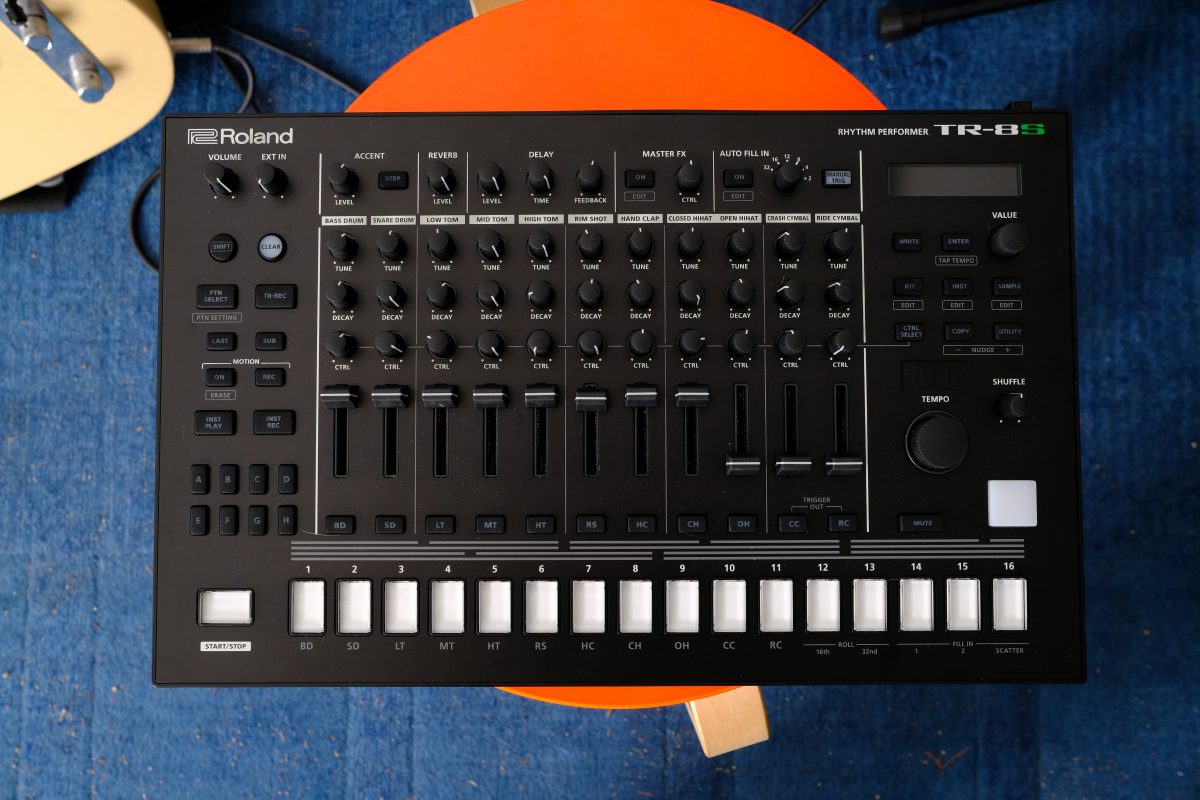First Look: Roland TR-8S Rhythm Performer
Roland adds sampling capabilities to its new performance machine.

Four years on, Roland has unveiled the successor to its AIRA TR-8 Rhythm Performer, which it’s dubbed the AIRA TR-8S. It’s the company’s new flagship drum machine and, as its name implies, it’s designed with live performance in mind.
The physical and UI design of the 8S is definitely in the same vein as the TR-8, maintaining a somewhat more subdued version of its signature green-and-black, “808 in The Matrix” stylings. The form factor is flatter and generally more symmetrical than its progenitor, if a bit bigger in terms of its physical footprint. The 8S sports a cleaner, more unified front panel design; while it has significantly more controls packed into a similar surface area, the 8S manages to look and feel cleaner than its forebear.
In addition to the tempo readout that graced the TR-8, there’s also a secondary LCD screen, which aids in scrubbing through the machine’s abundance of onboard sample content. To that end, the TR-8S is essentially a “greatest hits” of past Roland drum machines, bringing nearly all of the iconic TR drum sounds into one box. This includes recreations of the 808, 909, 707, 727, and 606, along with several modified versions of those machines. There’s a ton of additional onboard sound content, and the machine is equipped with an SD card slot for importing both mono and stereo user samples.
In terms of pattern generation, Roland’s “TR-REC” step sequencer returns with some modernizations—perhaps most notably a single, velocity-sensitive performance pad, which can be used to punch in patterns. The TR-8S sequencer can store 128 patterns, with eight variations and three fills contained in each; these patterns or variations can be triggered individually or chained together. The fills can be auto-sequenced at set intervals, or manually triggered via dedicated physical controls. Users can now save the tempo and kit assignments for individual patterns, along with knob positions and effect settings.
Like the TR-8, the 8S comes with onboard reverb and delay effects, the send mix of which can be handily dialed in per channel thanks to the aforementioned screen. A master global effect knob can be set to function as a filter, phaser, or any one of a number of punchy onboard effects. The Scatter section of the original TR-8 is gone, now essentially relegated to a single button on the bottom.
Finally, in terms of I/O, the 8S comes with balanced 1/4” mono and stereo mix outputs, as well as six assignable 1/4” audio outputs for externally processing and mixing its individual drum sounds. Modular users will be happy to know that there’s also a dedicated, sequenceable 1/8” trigger output; additionally, the assignable 1/4” outputs can be reconfigured to output trigger signals as well. Stereo audio inputs let users bring in external sound sources and, like the TR-8, the 8S also functions as a multi-channel USB audio/MIDI interface, with support for AIRA Link support (for those interested in daisy-chaining it with other AIRA gear).
All of the interface tweaks have clearly helped in terms of workflow: Combined with alternate “shift key” functionality for many of the buttons, the contextual menus allow you to quickly and easily swap between sounds and patterns, and there’s a lot that’s opened up in terms of customization because of this. Differentiating track faders by color helps with faster visual recognition in live performance, and the recordable Motion Controls are great for intuitively creating wild, evolving sequences (it’s also nice to be able to toggle this motion on and off with a dedicated button).
The TR-8S Rhythm Performer will be available later this month for $699 USD.
CLICK ANY PHOTO TO ENLARGE AND ENTER GALLERY BROWSING

